2.1 Neural and Hormonal Systems
Please proceed to the next section.
Biology, Behavior, and Mind
2-
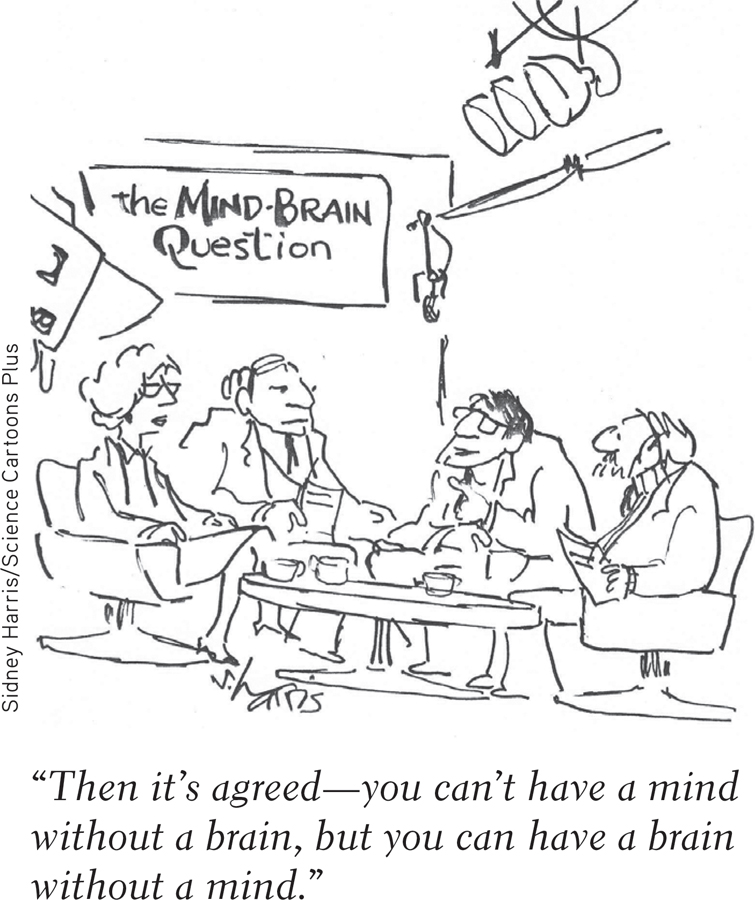
Your every idea, every mood, every urge is a biological happening. You love, laugh, and cry with your body. Without your body—
Our understanding of how the brain gives birth to the mind has come a long way. The ancient Greek philosopher Plato correctly located the mind in the spherical head—
In the early 1800s, German physician Franz Gall proposed that phrenology, studying bumps on the skull, could reveal a person’s mental abilities and character traits (FIGURE 2.1). At one point, Britain had 29 phrenological societies, and phrenologists traveled North America giving skull readings (Dean, 2012; Hunt, 1993). Using a false name, humorist Mark Twain put one famous phrenologist to the test. “He found a cavity [and] startled me by saying that that cavity represented the total absence of the sense of humor!” Three months later, Twain sat for a second reading, this time identifying himself. Now “the cavity was gone, and in its place was … the loftiest bump of humor he had ever encountered in his life-

 Figure 2.1
Figure 2.1A wrongheaded theory Despite initial acceptance of Franz Gall’s speculations, bumps on the skull tell us nothing about the brain’s underlying functions. Nevertheless, some of his assumptions have held true. Though they are not the functions Gall proposed, different parts of the brain do control different aspects of behavior, as suggested here (from The Human Brain Book) and as you will see throughout this chapter.
You and I are living in a time Gall could only dream about. By studying the links between biological activity and psychological events, those working from the biological perspective are announcing discoveries about the interplay of our biology and our behavior and mind at an exhilarating pace. Within little more than the past century, researchers seeking to understand the biology of the mind have discovered that
53
- among the body’s cells are nerve cells that conduct electricity and “talk” to one another by sending chemical messages across a tiny gap that separates them.
- specific brain systems serve specific functions (though not the functions Gall supposed).
- we integrate information processed in these different brain systems to construct our experience of sights and sounds, meanings and memories, pain and passion.
- our adaptive brain is wired by our experience.
biological perspective concerned with the links between biology and behavior. Includes psychologists working in neuroscience, behavior genetics, and evolutionary psychology. These researchers may call themselves behavioral neuroscientists, neuropsychologists, behavior geneticists, physiological psychologists, or biopsychologists.
We have also realized that we are each a system composed of subsystems that are in turn composed of even smaller subsystems. Tiny cells organize to form body organs. These organs form larger systems for digestion, circulation, and information processing. And those systems are part of an even larger system—
RETRIEVAL PRACTICE
- What do phrenology and psychology’s biological perspective have in common?
They share a focus on the links between the brain and behavior. Phrenology faded because it had no scientific basis—
Neural Communication
For scientists, it is a happy fact of nature that the information systems of humans and other animals operate similarly—
Neurons
2-
neuron a nerve cell; the basic building block of the nervous system.
Our body’s neural information system is complexity built from simplicity. Its building blocks are neurons, or nerve cells. To fathom our thoughts and actions, our memories and moods, we must first understand how neurons work and communicate.
Neurons differ, but all are variations on the same theme (FIGURE 2.2 below). Each consists of a cell body and its branching fibers. The bushy dendrite fibers receive information and conduct it toward the cell body. From there, the cell’s single lengthy axon fiber passes the message through its terminal branches to other neurons or to muscles or glands. Dendrites listen. Axons speak.
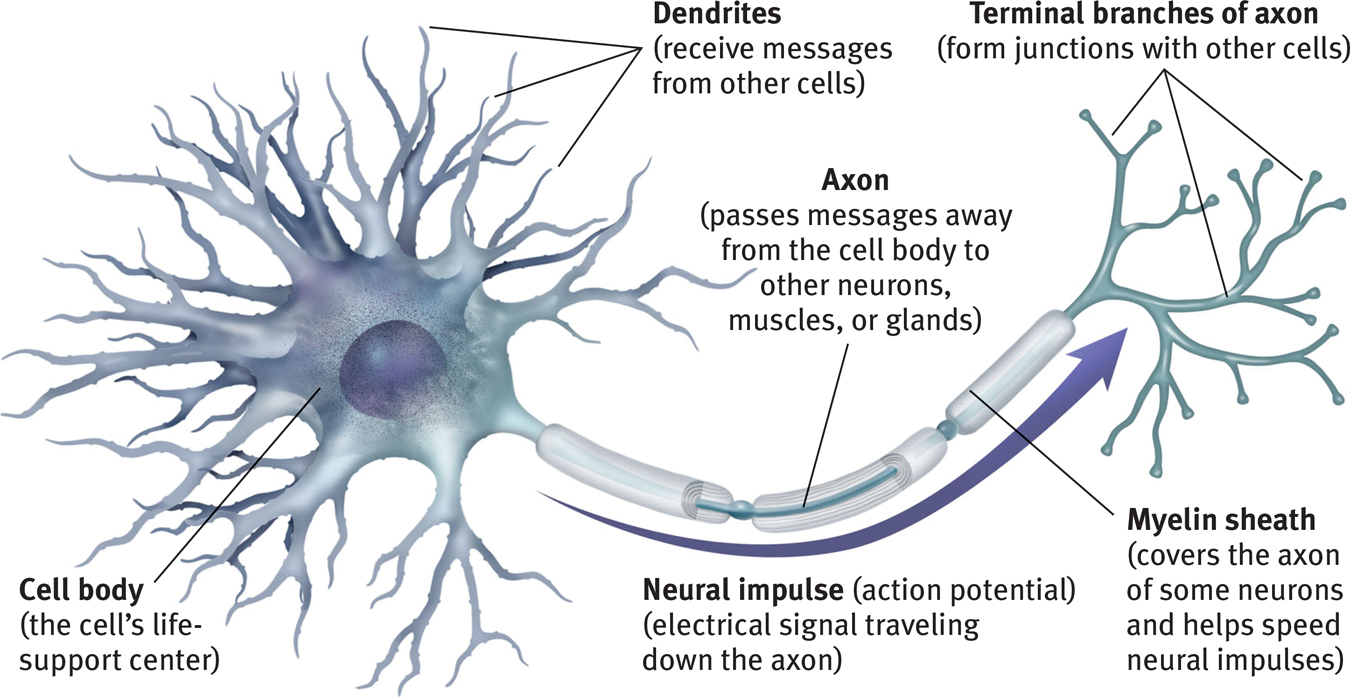
 Figure 2.2
Figure 2.2A motor neuron
dendrites a neuron’s bushy, branching extensions that receive messages and conduct impulses toward the cell body.
axon the neuron extension that passes messages through its branches to other neurons or to muscles or glands.
 To review and assess your understanding of neurons, visit LaunchPad’s Concept Practice: Structure of a Motor Neuron.
To review and assess your understanding of neurons, visit LaunchPad’s Concept Practice: Structure of a Motor Neuron.
myelin [MY-uh-lin] sheath a fatty tissue layer segmentally encasing the axons of some neurons; enables vastly greater transmission speed as neural impulses hop from one node to the next.
Unlike the short dendrites, axons may be very long, projecting several feet through the body. A human neuron carrying orders to a leg muscle, for example, has a cell body and axon roughly on the scale of a basketball attached to a 4-
54
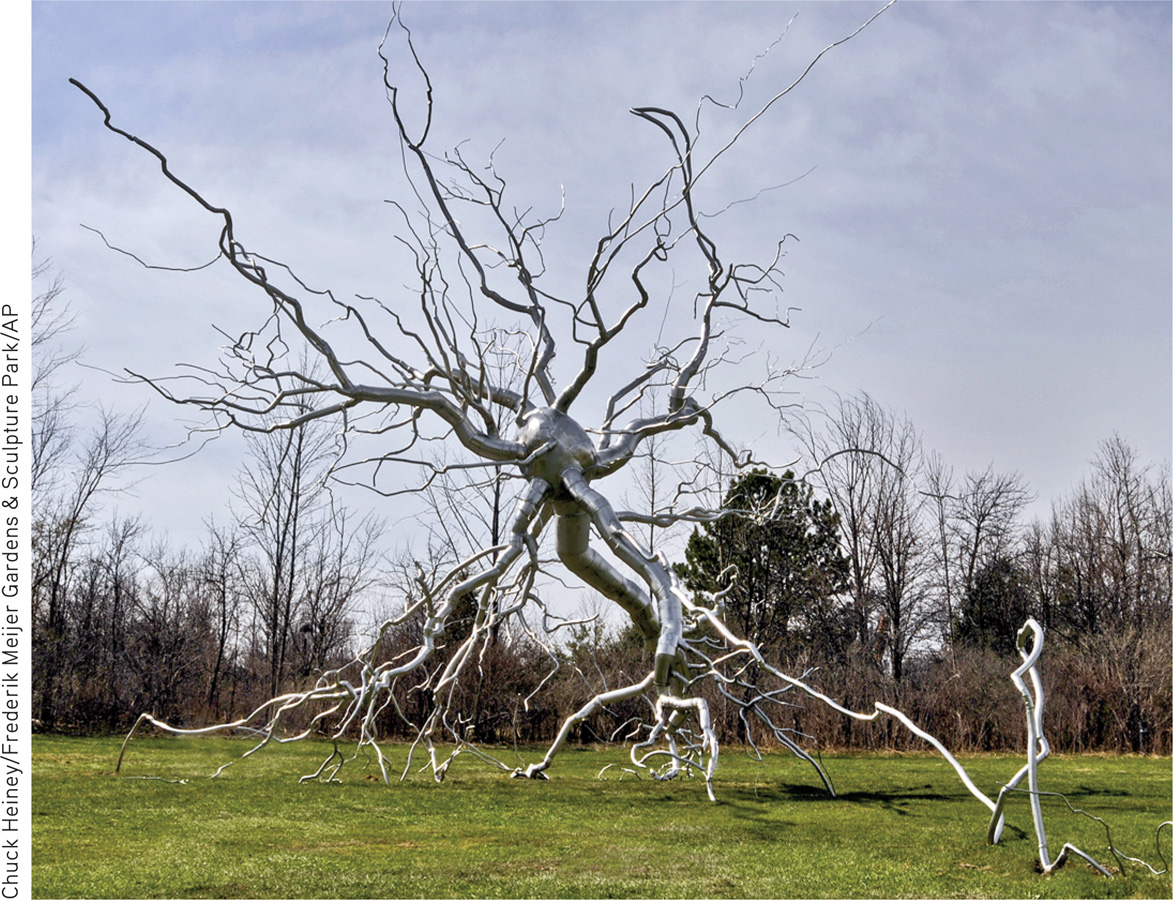
glial cells (glia) cells in the nervous system that support, nourish, and protect neurons; they may also play a role in learning, thinking, and memory.
Supporting these billions of nerve cells are spidery glial cells (“glue cells”). Neurons are like queen bees; on their own they cannot feed or sheathe themselves. Glial cells are worker bees. They provide nutrients and insulating myelin, guide neural connections, and mop up ions and neurotransmitters. Glia also play a role in learning and thinking. By “chatting” with neurons they participate in information transmission and memory (Fields, 2011, 2013; Miller, 2005).
In more complex animal brains, the proportion of glia to neurons increases. A postmortem analysis of Einstein’s brain did not find more or larger-
The Neural Impulse
action potential a neural impulse; a brief electrical charge that travels down an axon.
Neurons transmit messages when stimulated by signals from our senses or when triggered by chemical signals from neighboring neurons. In response, a neuron fires an impulse, called the action potential—a brief electrical charge that travels down its axon.
Depending on the type of fiber, a neural impulse travels at speeds ranging from a sluggish 2 miles per hour to more than 200 miles per hour. But even its top speed is 3 million times slower than that of electricity through a wire. We measure brain activity in milliseconds (thousandths of a second) and computer activity in nanoseconds (billionths of a second). Thus, unlike the nearly instantaneous reactions of a computer, your reaction to a sudden event, such as a child darting in front of your car, may take a quarter-
Like batteries, neurons generate electricity from chemical events. In the neuron’s chemistry-
“I sing the body electric.”
Walt Whitman, “Children of Adam” (1855)
55
When a neuron fires, however, the security parameters change: The first section of the axon opens its gates, rather like sewer covers flipping open, and positively charged sodium ions flood in (FIGURE 2.3). The loss of the inside/outside charge difference, called depolarization, causes the next axon channel to open, and then the next, like falling dominos, each tripping the next. This temporary inflow of positive ions is the neural impulse—

 Figure 2.3
Figure 2.3Action potential

refractory period a period of inactivity after a neuron has fired.
During a resting pause called the refractory period, the neuron pumps the positively charged sodium ions back outside. Then it can fire again. (In myelinated neurons, as in Figure 2.2, the action potential speeds up by hopping from the end of one myelin “sausage” to the next.) The mind boggles when imagining this electrochemical process repeating up to 100 or even 1000 times a second. But this is just the first of many astonishments.
 For an animated explanation of this process, visit LaunchPad’s Concept Practice: Action Potentials.
For an animated explanation of this process, visit LaunchPad’s Concept Practice: Action Potentials.
threshold the level of stimulation required to trigger a neural impulse.
Each neuron is itself a miniature decision-
“What one neuron tells another neuron is simply how much it is excited.”
Francis Crick, The Astonishing Hypothesis, 1994
all-or-none response a neuron’s reaction of either firing (with a full-strength response) or not firing.
Increasing the level of stimulation above the threshold will not increase the neural impulse’s intensity. The neuron’s reaction is an all-or-none response: Like guns, neurons either fire or they don’t. How, then, do we detect the intensity of a stimulus? How do we distinguish a gentle touch from a big hug? A strong stimulus can trigger more neurons to fire, and to fire more often. But it does not affect the action potential’s strength or speed. Squeezing a trigger harder won’t make a bullet go faster.
56
RETRIEVAL PRACTICE
- When a neuron fires an action potential, the information travels through the axon, the dendrites, and the cell body, but not in that order. Place these three structures in the correct order.
dendrites, cell body, axon
- How does our nervous system allow us to experience the difference between a slap and a tap on the back?
Stronger stimuli (the slap) cause more neurons to fire and to fire more frequently than happens with weaker stimuli (the tap).
How Neurons Communicate
2-
synapse [SIN-aps] the junction between the axon tip of the sending neuron and the dendrite or cell body of the receiving neuron. The tiny gap at this junction is called the synaptic gap or synaptic cleft.
Neurons interweave so intricately that even with a microscope you would have trouble seeing where one neuron ends and another begins. Scientists once believed that the axon of one cell fused with the dendrites of another in an uninterrupted fabric. Then British physiologist Sir Charles Sherrington (1857–
We now know that the axon terminal of one neuron is in fact separated from the receiving neuron by a synaptic gap (or synaptic cleft) less than a millionth of an inch wide. Spanish anatomist Santiago Ramón y Cajal (1852–
“All information processing in the brain involves neurons ‘talking to’ each other at synapses.”
Neuroscientist Solomon H. Snyder (1984)
neurotransmitters chemical messengers that cross the synaptic gaps between neurons. When released by the sending neuron, neurotransmitters travel across the synapse and bind to receptor sites on the receiving neuron, thereby influencing whether that neuron will generate a neural impulse.
When an action potential reaches the knob-
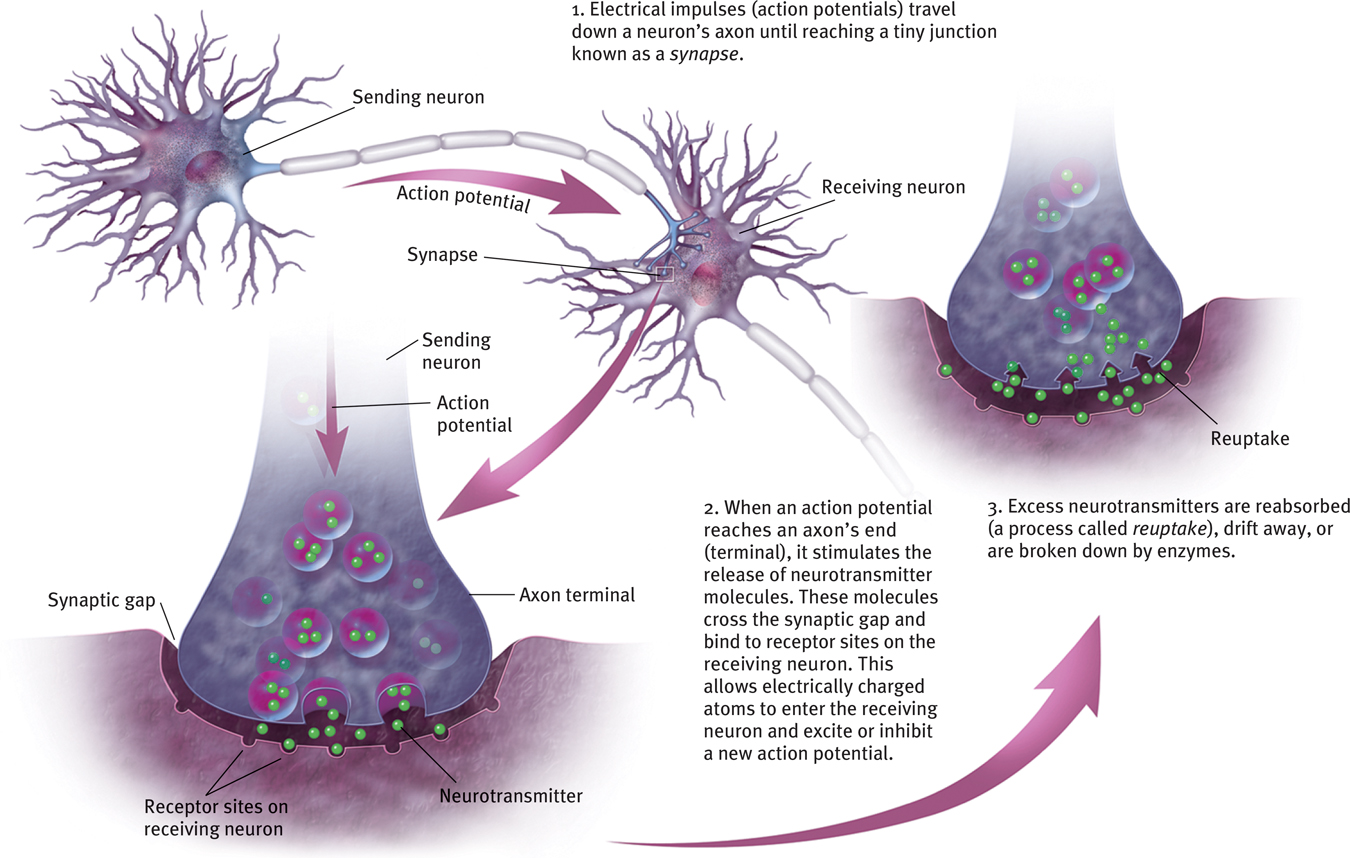
 Figure 2.4
Figure 2.4How neurons communicate
reuptake a neurotransmitter’s reabsorption by the sending neuron.
RETRIEVAL PRACTICE
- What happens in the synaptic gap?
Neurons send neurotransmitters (chemical messengers) across this tiny space between one neuron’s terminal branch and the next neuron’s dendrite or cell body.
- What is reuptake? What two other things can happen to excess neurotransmitters after a neuron reacts?
Reuptake occurs when excess neurotransmitters are reabsorbed by the sending neuron. (They can also drift away or be broken down by enzymes.)
“When it comes to the brain, if you want to see the action, follow the neurotransmitters.”
Neuroscientist Floyd Bloom (1993)
How Neurotransmitters Influence Us
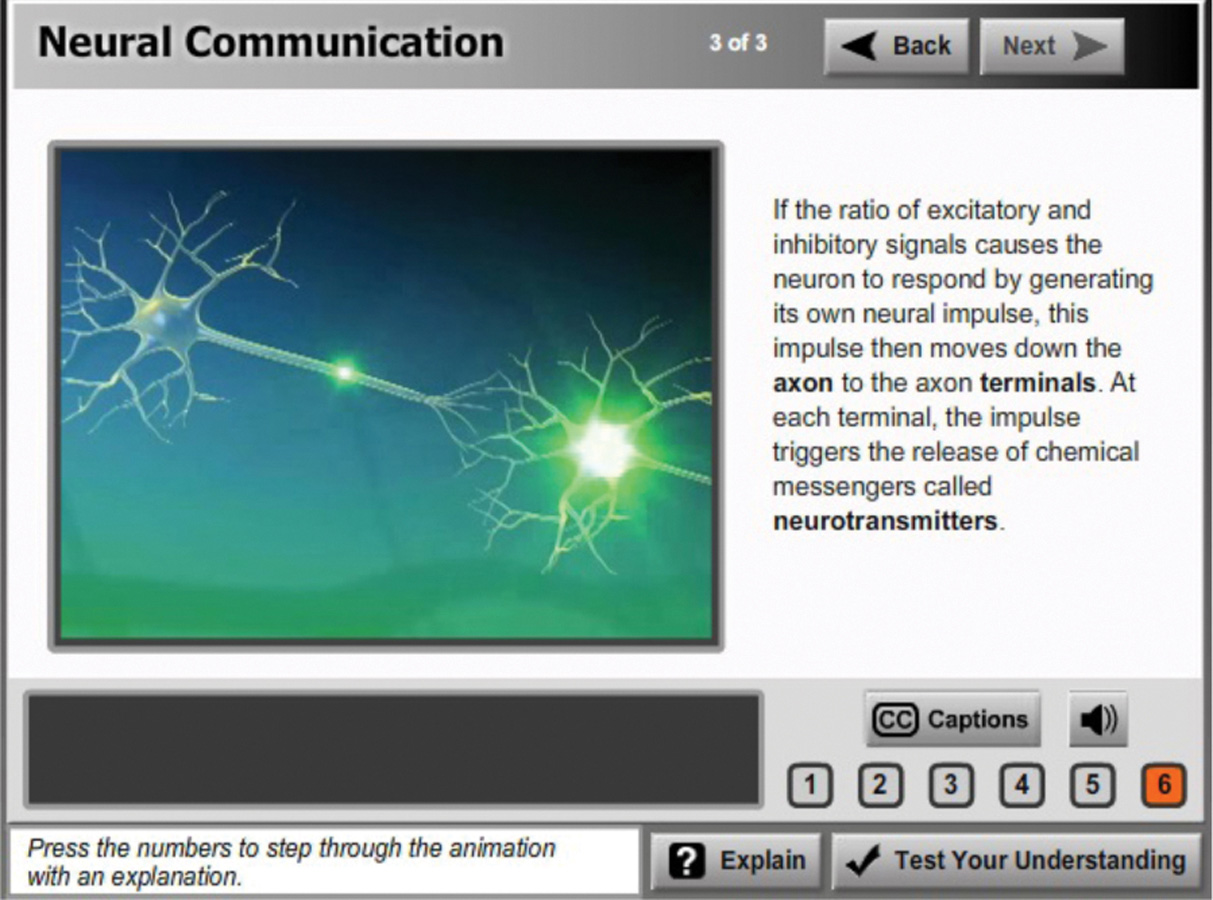
 For an animated explanation, visit LaunchPad’s Concept Practice activities: Structure of a Synapse and Neural Communication.
For an animated explanation, visit LaunchPad’s Concept Practice activities: Structure of a Synapse and Neural Communication.
2-
In their quest to understand neural communication, researchers have discovered several dozen neurotransmitters and as many new questions: Are certain neurotransmitters found only in specific places? How do they affect our moods, memories, and mental abilities? Can we boost or diminish these effects through drugs or diet?
57
Later chapters explore neurotransmitter influences on hunger and thinking, depression and euphoria, addictions and therapy. For now, let’s glimpse how neurotransmitters influence our motions and our emotions. A particular brain pathway may use only one or two neurotransmitters (FIGURE 2.5), and particular neurotransmitters may affect specific behaviors and emotions (TABLE 2.1 below). But neurotransmitter systems don’t operate in isolation; they interact, and their effects vary with the receptors they stimulate. Acetylcholine (ACh), which is one of the best-

 Figure 2.5
Figure 2.5Neurotransmitter pathways Each of the brain’s differing chemical messengers has designated pathways where it operates, as shown here for serotonin and dopamine (Carter, 1998).

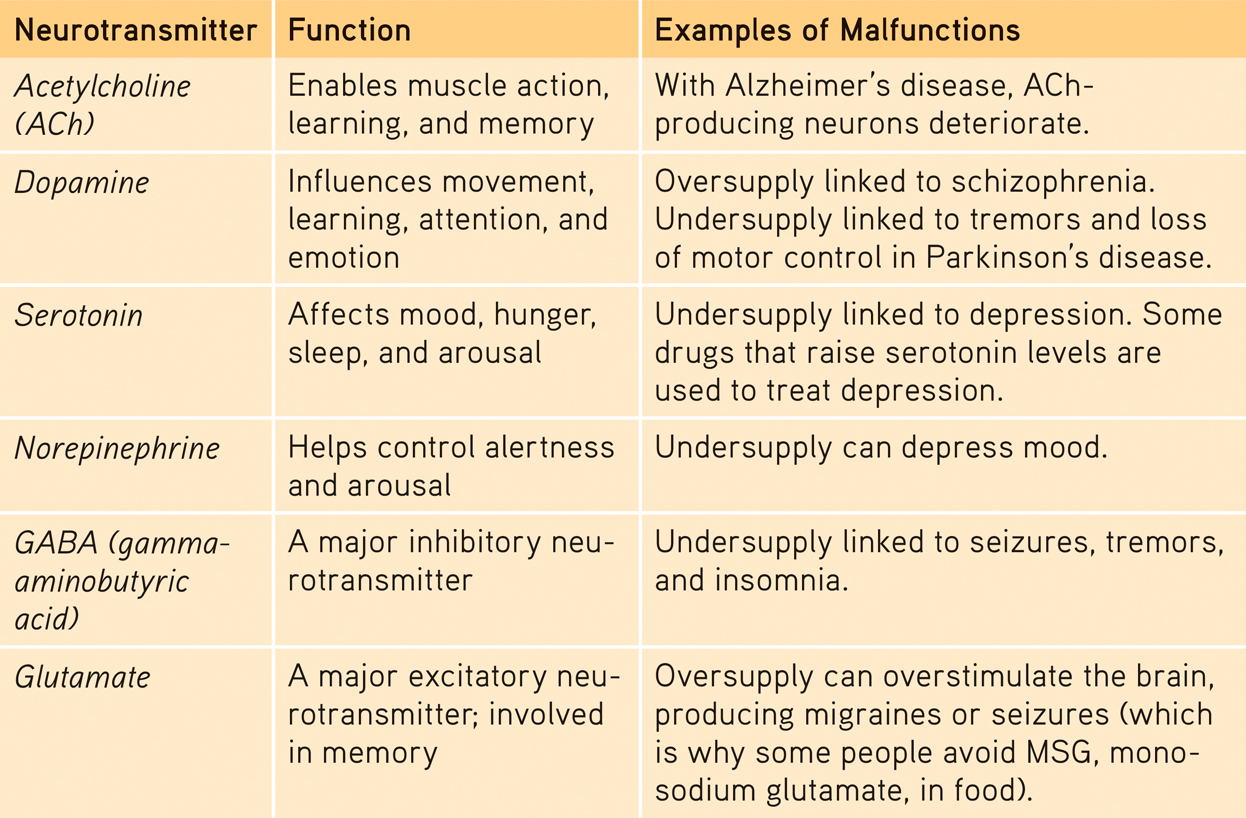
 Table 2.1
Table 2.1Some Neurotransmitters and Their Functions
58
Candace Pert and Solomon Snyder (1973) made an exciting discovery about neurotransmitters when they attached a radioactive tracer to morphine, showing where it was taken up in an animal’s brain. The morphine, an opiate drug that elevates mood and eases pain, bound to receptors in areas linked with mood and pain sensations. But why would the brain have these “opiate receptors”? Why would it have a chemical lock, unless it also had a natural key to open it?
Physician Lewis Thomas, on the endorphins: “There it is, a biologically universal act of mercy. I cannot explain it, except to say that I would have put it in had I been around at the very beginning, sitting as a member of a planning committee.”
The Youngest Science, 1983
endorphins [en-DOR-fins] “morphine within”—natural, opiate-like neurotransmitters linked to pain control and to pleasure.
Researchers soon confirmed that the brain does indeed produce its own naturally occurring opiates. Our body releases several types of neurotransmitter molecules similar to morphine in response to pain and vigorous exercise. These endorphins (short for endogenous [produced within] morphine) help explain good feelings such as the “runner’s high,” the painkilling effects of acupuncture, and the indifference to pain in some severely injured people. But once again, new knowledge led to new questions.
RETRIEVAL PRACTICE
- Serotonin, dopamine, and endorphins are all chemical messengers called ______________.
neurotransmitters
How Drugs and Other Chemicals Alter Neurotransmission If indeed the endorphins lessen pain and boost mood, why not flood the brain with artificial opiates, thereby intensifying the brain’s own “feel-
59
agonist a molecule that increases a neurotransmitter’s action.
Drugs and other chemicals affect brain chemistry, often by either exciting or inhibiting neurons’ firing. Agonist molecules increase a neurotransmitter’s action. Agonists may increase the production or release of neurotransmitters, or block reuptake in the synapse. Other agonists may be similar enough to a neurotransmitter to bind to its receptor and mimic its excitatory or inhibitory effects. Some opiate drugs are agonists and produce a temporary “high” by amplifying normal sensations of arousal or pleasure.
antagonist a molecule that inhibits or blocks a neurotransmitter’s action.
Antagonists decrease a neurotransmitter’s action by blocking production or release. Botulin, a poison that can form in improperly canned food, causes paralysis by blocking ACh release. (Small injections of botulin—
 For an illustrated review of neural communication, visit LaunchPad’s PsychSim 6: Neural Messages.
For an illustrated review of neural communication, visit LaunchPad’s PsychSim 6: Neural Messages.
RETRIEVAL PRACTICE
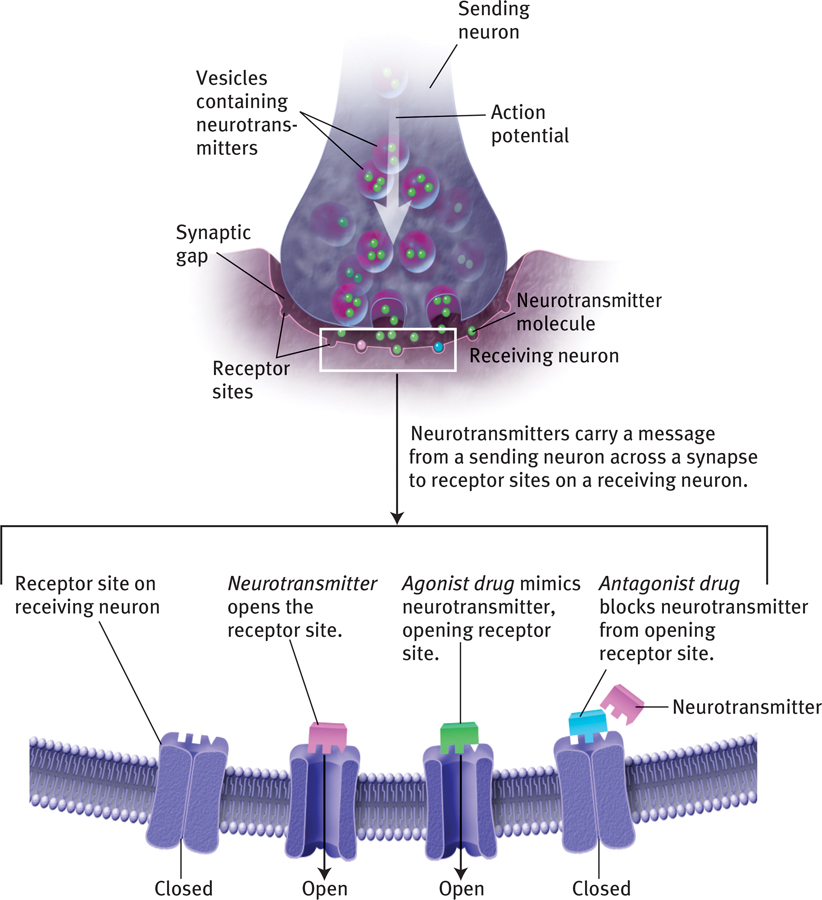
 Figure 2.6
Figure 2.6Agonists and antagonists
- Curare poisoning paralyzes its victims by blocking ACh receptors involved in muscle movements. Morphine mimics endorphin actions. Which is an agonist, and which is an antagonist?
Morphine is an agonist; curare is an antagonist.
60
The Nervous System
2-
To live is to take in information from the world and the body’s tissues, to make decisions, and to send back information and orders to the body’s tissues. All this happens thanks to our body’s nervous system (FIGURE 2.7). A quick overview: The brain and spinal cord form the central nervous system (CNS), the body’s decision maker. The peripheral nervous system (PNS) is responsible for gathering information and for transmitting CNS decisions to other body parts. Nerves, electrical cables formed of bundles of axons, link the CNS with the body’s sensory receptors, muscles, and glands. The optic nerve, for example, bundles a million axons into a single cable carrying the messages each eye sends to the brain (Mason & Kandel, 1991).

 Figure 2.7
Figure 2.7The functional divisions of the human nervous system
nervous system the body’s speedy, electrochemical communication network, consisting of all the nerve cells of the peripheral and central nervous systems.
central nervous system (CNS) the brain and spinal cord.
peripheral nervous system (PNS) the sensory and motor neurons that connect the central nervous system (CNS) to the rest of the body.
nerves bundled axons that form neural cables connecting the central nervous system with muscles, glands, and sense organs.
sensory (afferent) neurons neurons that carry incoming information from the sensory receptors to the brain and spinal cord.
Information travels in the nervous system through three types of neurons. Sensory neurons carry messages from the body’s tissues and sensory receptors inward (thus, they are afferent) to the brain and spinal cord for processing. Motor neurons (which are efferent) carry instructions from the central nervous system out to the body’s muscles and glands. Between the sensory input and motor output, information is processed via the brain’s interneurons. Our complexity resides mostly in these interneurons. Our nervous system has a few million sensory neurons, a few million motor neurons, and billions and billions of interneurons.
motor (efferent) neurons neurons that carry outgoing information from the brain and spinal cord to the muscles and glands.
interneurons neurons within the brain and spinal cord; communicate internally and process information between the sensory inputs and motor outputs.
The Peripheral Nervous System
somatic nervous system the division of the peripheral nervous system that controls the body’s skeletal muscles. Also called the skeletal nervous system.
Our peripheral nervous system has two components—
autonomic [aw-tuh-NAHM-ik] nervous system (ANS) the part of the peripheral nervous system that controls the glands and the muscles of the internal organs (such as the heart). Its sympathetic division arouses; its parasympathetic division calms.
Our autonomic nervous system (ANS) controls our glands and our internal organ muscles, thus influencing glandular activity, heartbeat, and digestion. (Autonomic means “self-
61
The autonomic nervous system serves two important functions (FIGURE 2.8). The sympathetic nervous system arouses and expends energy. If something alarms or challenges you (such as a longed-
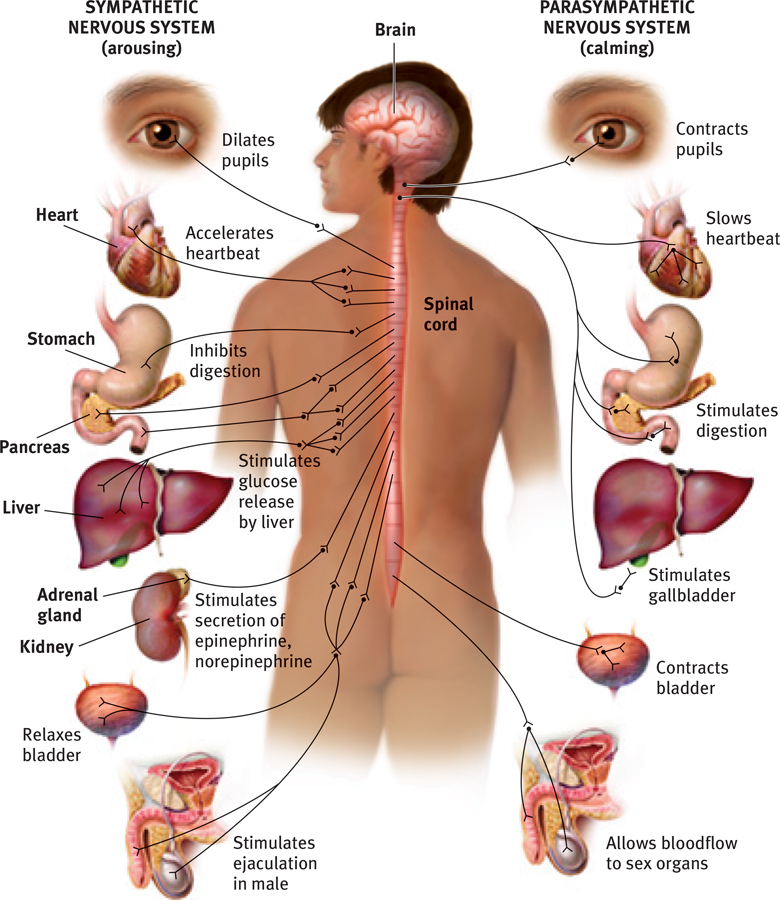
 Figure 2.8
Figure 2.8The dual functions of the autonomic nervous system The autonomic nervous system controls the more autonomous (or self-
sympathetic nervous system the division of the autonomic nervous system that arouses the body, mobilizing its energy.
parasympathetic nervous system the division of the autonomic nervous system that calms the body, conserving its energy.
I [DM] recently experienced my ANS in action. Before sending me into an MRI machine for a routine shoulder scan, the technician asked if I had issues with claustrophobia. “No, I’m fine,” I assured her, with perhaps a hint of macho swagger. Moments later, as I found myself on my back, stuck deep inside a coffin-
62
RETRIEVAL PRACTICE
- Match the type of neuron to its description.
TypeDescription
1. Motor neurons a. carry incoming messages
from sensory receptors
to the CNS.
2. Sensory neurons b. communicate within the
CNS and process information
between incoming and
outgoing messages.
3. Interneurons c. carry outgoing messages
from the CNS to muscles
and glands.
1. c, 2. a, 3. b
- What bodily changes does your ANS direct before and after you give an important speech?
Responding to this challenge, your ANS sympathetic division will arouse you. It accelerates your heartbeat, raises your blood pressure and blood sugar, slows your digestion, and cools you with perspiration. After you give the speech, your ANS parasympathetic division will reverse these effects.
The Central Nervous System

From neurons “talking” to other neurons arises the complexity of the central nervous system’s brain and spinal cord.
It is the brain that enables our humanity—
The brain’s neurons cluster into work groups called neural networks. To understand why, Stephen Kosslyn and Olivier Koenig (1992, p. 12) have invited us to “think about why cities exist; why don’t people distribute themselves more evenly across the countryside?” Like people networking with people, neurons network with nearby neurons with which they can have short, fast connections. As in FIGURE 2.9, each layer’s cells connect with various cells in the neural network’s next layer. Learning—

 Figure 2.9
Figure 2.9A simplified neural network Neurons network with nearby neurons. Encoded in these networks is your own enduring identity (as a musician, an athlete, a devoted friend)—your sense of self that extends across the years. How neural networks organize themselves into complex circuits capable of learning, feeling, and thinking remains one of the great scientific mysteries. How does biology give birth to mind?
reflex a simple, automatic response to a sensory stimulus, such as the knee-jerk response.
The other part of the CNS, the spinal cord, is a two-
63
Another neural circuit enables the pain reflex (FIGURE 2.10). When your finger touches a flame, neural activity (excited by the heat) travels via sensory neurons to interneurons in your spinal cord. These interneurons respond by activating motor neurons leading to the muscles in your arm. Because the simple pain-
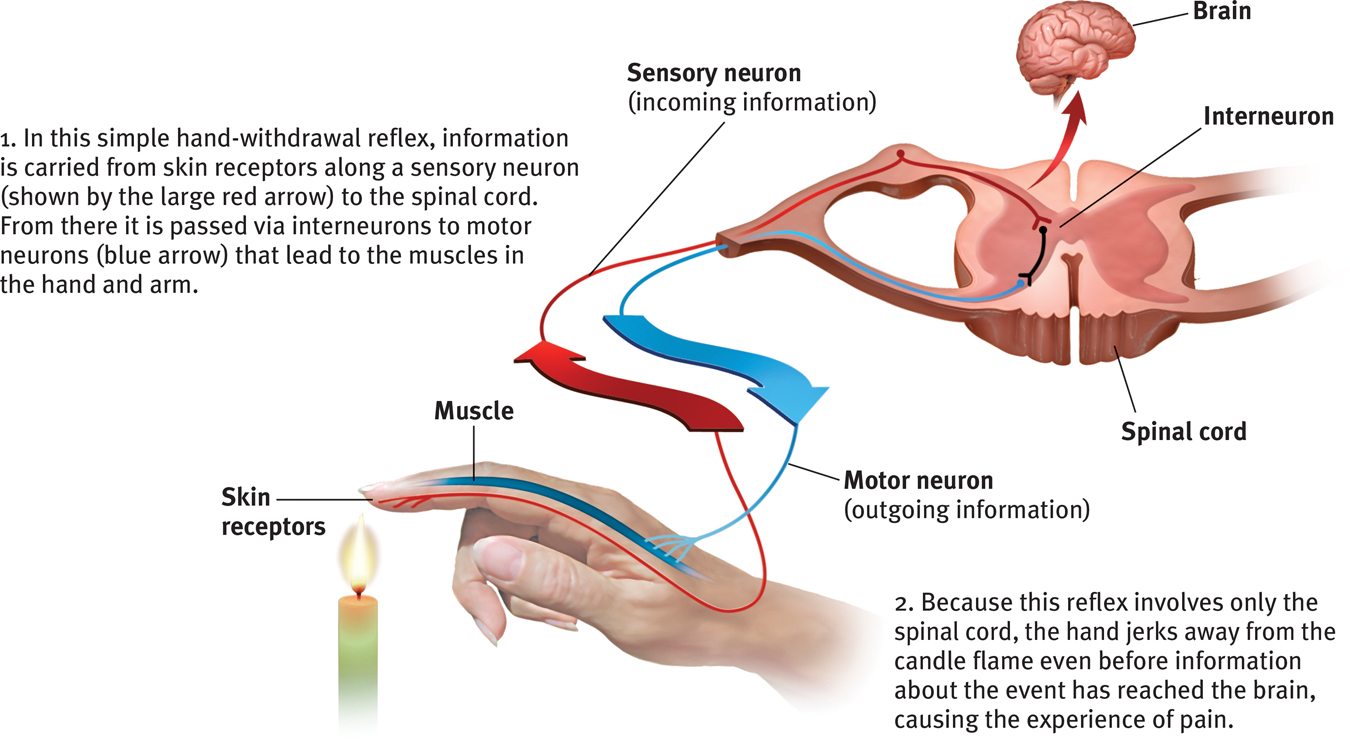
 Figure 2.10
Figure 2.10A simple reflex
“If the nervous system be cut off between the brain and other parts, the experiences of those other parts are nonexistent for the mind. The eye is blind, the ear deaf, the hand insensible and motionless.”
William James, Principles of Psychology, 1890
Information travels to and from the brain by way of the spinal cord. Were the top of your spinal cord severed, you would not feel pain from your paralyzed body below. Nor would you feel pleasure. With your brain literally out of touch with your body, you would lose all sensation and voluntary movement in body regions with sensory and motor connections to the spinal cord below its point of injury. You would exhibit the knee-
The Endocrine System
2-
So far we have focused on the body’s speedy electrochemical information system. Interconnected with your nervous system is a second communication system, the endocrine system (FIGURE 2.11 below). The endocrine system’s glands secrete another form of chemical messengers, hormones, which travel through the bloodstream and affect other tissues, including the brain. When hormones act on the brain, they influence our interest in sex, food, and aggression.
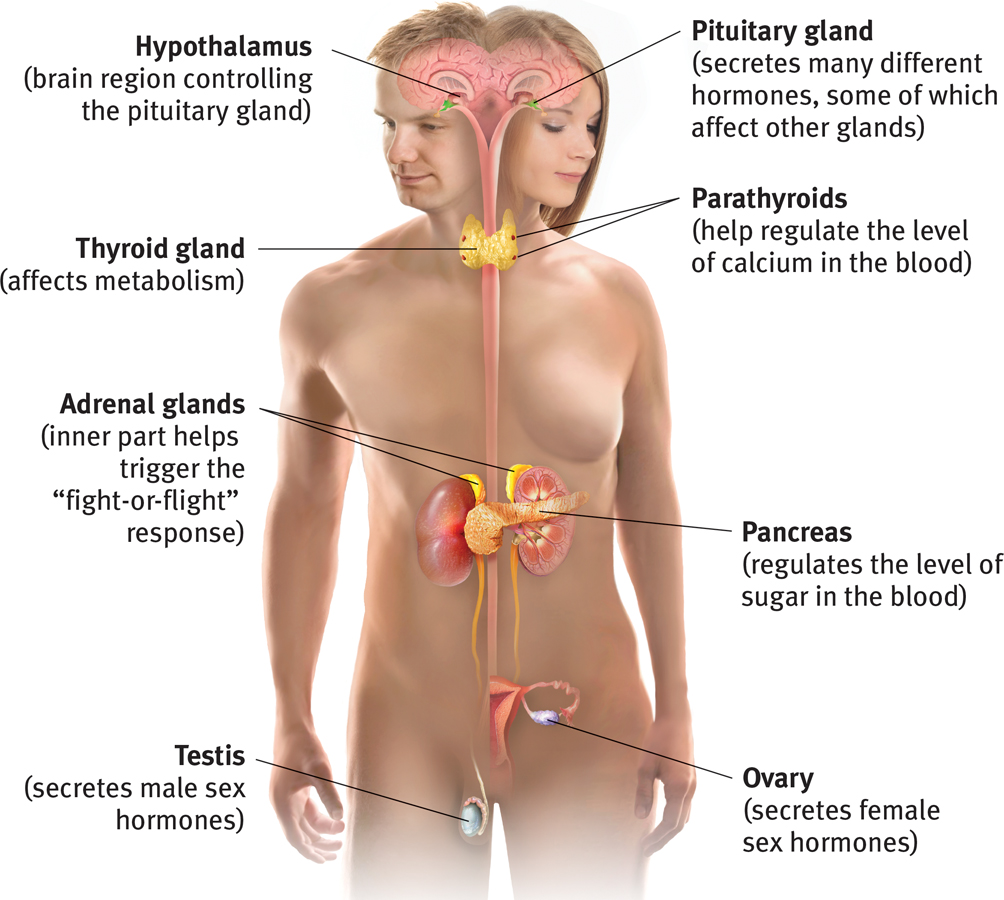
 Figure 2.11
Figure 2.11The endocrine system
endocrine [EN-duh-krin] system the body’s “slow” chemical communication system; a set of glands that secrete hormones into the bloodstream.
hormones chemical messengers that are manufactured by the endocrine glands, travel through the bloodstream, and affect other tissues.
64
Some hormones are chemically identical to neurotransmitters (the chemical messengers that diffuse across a synapse and excite or inhibit an adjacent neuron). The endocrine system and nervous system are therefore close relatives: Both produce molecules that act on receptors elsewhere. Like many relatives, they also differ. The speedy nervous system zips messages from eyes to brain to hand in a fraction of a second. Endocrine messages trudge along in the bloodstream, taking several seconds or more to travel from the gland to the target tissue. If the nervous system transmits information with text-
But slow and steady sometimes wins the race. Endocrine messages tend to outlast the effects of neural messages. Upset feelings may linger beyond our awareness of the reason, and it takes time for us to “simmer down.” The persistence of emotions—
adrenal [ah-DREEN-el] glands a pair of endocrine glands that sit just above the kidneys and secrete hormones (epinephrine and norepinephrine) that help arouse the body in times of stress.
In a moment of danger, the ANS orders the adrenal glands on top of the kidneys to release epinephrine and norepinephrine (also called adrenaline and noradrenaline). These hormones increase heart rate, blood pressure, and blood sugar, providing a surge of energy. When the emergency passes, the hormones—
pituitary gland the endocrine system’s most influential gland. Under the influence of the hypothalamus, the pituitary regulates growth and controls other endocrine glands.
The most influential endocrine gland is the pituitary gland, a pea-
Pituitary secretions also direct other endocrine glands to release their hormones. The pituitary, then, is a master gland (whose own master is the hypothalamus). For example, under the brain’s influence, the pituitary triggers your sex glands to release sex hormones. These in turn influence your brain and behavior. So, too, with stress. A stressful event triggers your hypothalamus to instruct your pituitary to release a hormone that causes your adrenal glands to flood your body with cortisol, a stress hormone that increases blood sugar.
65
This feedback system (brain → pituitary → other glands → hormones → body and brain) reveals the intimate connection of the nervous and endocrine systems. The nervous system directs endocrine secretions, which then affect the nervous system. Conducting and coordinating this whole electrochemical orchestra is that maestro we call the brain.
RETRIEVAL PRACTICE
- Why is the pituitary gland called the “master gland”?
Responding to signals from the hypothalamus, the pituitary releases hormones that trigger other endocrine glands to secrete hormones, which in turn influence brain and behavior.
- How are the nervous and endocrine systems alike, and how do they differ?
Both of these communication systems produce chemical molecules that act on the body’s receptors to influence our behavior and emotions. The endocrine system, which secretes hormones into the bloodstream, delivers its messages much more slowly than the speedy nervous system, and the effects of the endocrine system’s messages tend to linger much longer than those of the nervous system.
REVIEW: Neural and Hormonal Systems

|
REVIEW | Neural and Hormonal Systems |
LEARNING OBJECTIVES
RETRIEVAL PRACTICE Take a moment to answer each of these Learning Objective Questions (repeated here from within this section). Then click the 'show answer' button to check your answers. Research suggests that trying to answer these questions on your own will improve your long-
2-
Psychologists working from a biological perspective study the links between biology and behavior. We are biopsychosocial systems, in which biological, psychological, and social-cultural factors interact to influence behavior.
2-
Neurons are the elementary components of the nervous system, the body’s speedy electrochemical information system. A neuron receives signals through its branching dendrites, and sends signals through its axons. Some axons are encased in a myelin sheath, which enables faster transmission. Glial cells provide myelin, and they support, nourish, and protect neurons; they may also play a role in learning and thinking.
If the combined signals received by a neuron exceed a minimum threshold, the neuron fires, transmitting an electrical impulse (the action potential) down its axon by means of a chemistry-to-electricity process. The neuron’s reaction is an all-or-none process.
2-
When action potentials reach the end of an axon (the axon terminals), they stimulate the release of neurotransmitters. These chemical messengers carry a message from the sending neuron across a synapse to receptor sites on a receiving neuron. The sending neuron, in a process called reuptake, then normally reabsorbs the excess neurotransmitter molecules in the synaptic gap. If incoming signals are strong enough, the receiving neuron generates its own action potential and relays the message to other cells.
2-
Neurotransmitters travel designated pathways in the brain and may influence specific behaviors and emotions. Acetylcholine (ACh) affects muscle action, learning, and memory. Endorphins are natural opiates released in response to pain and exercise.
Drugs and other chemicals affect brain chemistry at synapses. Agonists increase a neurotransmitter’s action, and may do so in various ways. Antagonists decrease a neurotransmitter’s action by blocking production or release.
2-
The central nervous system (CNS)—the brain and the spinal cord—is the nervous system’s decision maker. The peripheral nervous system (PNS), which connects the CNS to the rest of the body by means of nerves, gathers information and transmits CNS decisions to the rest of the body. The two main PNS divisions are the somatic nervous system (which enables voluntary control of the skeletal muscles) and the autonomic nervous system (which controls involuntary muscles and glands by means of its sympathetic and parasympathetic divisions).
Neurons cluster into working networks. There are three types of neurons: (1) Sensory (afferent) neurons carry incoming information from sensory receptors to the brain and spinal cord. (2) Motor (efferent) neurons carry information from the brain and spinal cord out to the muscles and glands. (3) Interneurons communicate within the brain and spinal cord and between sensory and motor neurons.
2-
The endocrine system is a set of glands that secrete hormones into the bloodstream, where they travel through the body and affect other tissues, including the brain. The endocrine system’s master gland, the pituitary, influences hormone release by other glands, including the adrenal glands. In an intricate feedback system, the brain’s hypothalamus influences the pituitary gland, which influences other glands, which release hormones, which in turn influence the brain.
TERMS AND CONCEPTS TO REMEMBER
RETRIEVAL PRACTICE Match each of the terms on the left with its definition on the right. Click on the term first and then click on the matching definition. As you match them correctly they will move to the bottom of the activity.
Question
biological perspective neuron dendrites axon myelin [MY-uh-lin] sheath glial cells (glia) action potential refractory period threshold all-or-none response synapse [SIN-aps] neurotransmitters reuptake endorphins [en-DOR-fins] agonist antagonist nervous system central nervous system (CNS) peripheral nervous system (PNS) nerves sensory (afferent) neurons motor (efferent) neurons interneurons somatic nervous system autonomic [aw-tuh-NAHM-ik] nervous system (ANS) sympathetic nervous system parasympathetic nervous system reflex endocrine [EN-duh-krin] system hormones adrenal [ah-DREEN-el] glands pituitary gland | the body’s “slow” chemical communication system; a set of glands that secrete hormones into the bloodstream. a nerve cell; the basic building block of the nervous system. chemical messengers that cross the synaptic gaps between neurons. When released by the sending neuron, neurotransmitters travel across the synapse and bind to receptor sites on the receiving neuron, thereby influencing whether that neuron will generate a neural impulse. the division of the autonomic nervous system that arouses the body, mobilizing its energy. bundled axons that form neural cables connecting the central nervous system with muscles, glands, and sense organs. a simple, automatic response to a sensory stimulus, such as the knee-jerk response. a fatty tissue layer segmentally encasing the axons of some neurons; enables vastly greater transmission speed as neural impulses hop from one node to the next. the division of the peripheral nervous system that controls the body’s skeletal muscles. Also called the skeletal nervous system. a neuron’s bushy, branching extensions that receive messages and conduct impulses toward the cell body. the neuron extension that passes messages through its branches to other neurons or to muscles or glands. the level of stimulation required to trigger a neural impulse. a neural impulse; a brief electrical charge that travels down an axon. neurons that carry outgoing information from the brain and spinal cord to the muscles and glands. the sensory and motor neurons that connect the central nervous system (CNS) to the rest of the body. the part of the peripheral nervous system that controls the glands and the muscles of the internal organs (such as the heart). Its sympathetic division arouses; its parasympathetic division calms. “morphine within”—natural, opiate-like neurotransmitters linked to pain control and to pleasure. a pair of endocrine glands that sit just above the kidneys and secrete hormones (epinephrine and norepinephrine) that help arouse the body in times of stress. the body’s speedy, electrochemical communication network, consisting of all the nerve cells of the peripheral and central nervous systems. a molecule that increases a neurotransmitter’s action. the junction between the axon tip of the sending neuron and the dendrite or cell body of the receiving neuron. The tiny gap at this junction is called the synaptic gap or synaptic cleft. neurons that carry incoming information from the sensory receptors to the brain and spinal cord. a molecule that inhibits or blocks a neurotransmitter’s action. the endocrine system’s most influential gland. Under the influence of the hypothalamus, the pituitary regulates growth and controls other endocrine glands. a neuron’s reaction of either firing (with a full-strength response) or not firing. the division of the autonomic nervous system that calms the body, conserving its energy. concerned with the links between biology and behavior. Includes psychologists working in neuroscience, behavior genetics, and evolutionary psychology. These researchers may call themselves behavioral neuroscientists, neuropsychologists, behavior geneticists, physiological psychologists, or biopsychologists. a period of inactivity after a neuron has fired. neurons within the brain and spinal cord; communicate internally and process information between the sensory inputs and motor outputs. a neurotransmitter’s reabsorption by the sending neuron. the brain and spinal cord. chemical messengers that are manufactured by the endocrine glands, travel through the bloodstream, and affect other tissues. cells in the nervous system that support, nourish, and protect neurons; they may also play a role in learning, thinking, and memory. |
Use  to create your personalized study plan, which will direct you to the resources that will help you most in
to create your personalized study plan, which will direct you to the resources that will help you most in  .
.
66